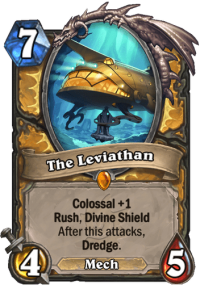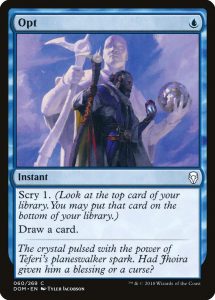Hearthstone’s latest keyword from the Voyage to the Sunken City set will most likely be familiar to veteran card game players. However, it will function a bit differently than you might expect based on those experiences. Here’s what to expect from it and how to make the best use of it once the expansion launches!
What Is Dredge and What Are Its Synergies?

Dredge reads “Look at the bottom 3 cards of your deck. Put one on top.” It allows you to have a minor impact on your next draw and to let you plan ahead better about your subsequent odds knowing which two cards are stuck on the bottom of your deck. In some ways, it has been soft-introduced in the Demon Hunter Initiate set with Sightless Watcher, though those cards weren’t taken from the bottom of your deck.
Functionally, the difference will come from other cards from this set that interact with Dredge and the bottom of your deck. Sightless Watcher was a serviceable filler in aggro decks and little more, so these synergies will make or break the power levels of this new keyword. Similar to what we’ve seen here, Dredge itself doesn’t shuffle the deck and it’s been confirmed that it will show duplicates if you’re (un)lucky enough to have two copies of the same card in the bottom three of your deck.
Anything that puts a “Sunken” card to the bottom of your deck is a great example of this, with the Azsharan cards (like Azsharan Vessel and Azsharan Mooncatcher) offering great payoffs at a fairly low setup requirement. The Leviathan, Paladin’s Colossal minion, is also a great example of how efficiently you can get hold of Dredge payoffs. It also shows just how great the flavor is on this mechanic
Then again, as cool as this interpretation of the mechanic is in Hearthstone, it’s not exactly new.
Scrying Similarities
Veteran card game players will immediately think of MTG’s Scry when seeing this keyword. (There is also an actual MTG keyword named Dredge, which functions a bit differently: it lets you mill X number of cards to return the card with Dredge from your graveyard to your hand. Since Hearthstone still doesn’t have a real graveyard feature, this is more of a “false friend” than anything else.
No, it’s Scry you should think of when looking at Hearthstone’s Dredge: it reads “Scry N (Look at the top N cards of your library, then put any number of them on the bottom of your library and the rest on top in any order.)” So for all intents and purposes, Dredge is Scry 1 with a bit of added information (or a limited version of Scry 3 if you will) and a nice use of Hearthstone’s existing play patterns with Discover’s three cards shown.
Though the mechanic is mainly Blue’s to play with, it is present in all colors at this stage to some extent (with Red, the most aggressive of types, getting the fewest options to Scry, and with good reason). Tailoring your draws with immediate effect can be very powerful, especially in a game like Hearthstone. It should also be of no surprise that classes with notable aggressive archetypes seem to have received fewer good Dredge cards: these strategies already have a built-in edge in Hearthstone since the attacker gets to sequence the attacks – another significant difference between this game and something like Magic that has influenced card design in tangible ways across the years.
Is Dredge a Good Fit for Hearthstone?

The risk of lifting a Magic-like keyword nearly wholesale is that Hearthstone’s developers got rid of a lot of the intrinsic RNG built into MTG. There is no “mana screw” or “mana flood” in Blizzard’s game, which is a big part of why the card design itself shifted more in the direction of wacky random escapades to facilitate higher variance in the gameplay.
This means that any effect that reduces variance in card draw is at a premium in Hearthstone and has a larger impact than it would in other card games. Still, as we’ve seen from Sightless Watcher, it won’t be enough to just slap this bad boy on a vanilla minion and expect it to see play: the power levels and the synergies are way beyond these levels in today’s Hearthstone.
The Sunken cards and the way some of the Legendaries were designed seem to suggest the developers are aware of this. Beyond being an excellent thematic fit, they also seem like interesting and viable tools for ladder play. Unlike Honorable Kill, which had little to no Constructed impact, there seems to be enough to work here for Dredge cards to see competitive play.
The fact that it is just one of two keywords introduced in the set (the other being Colossal), the first time the team has done so since The Witchwood, suggests that they’re expecting this set to have a pretty significant impact on the gameplay experience.
A straightforward effect with great thematic fit, relevant decision points and added information, Dredge is an interesting and valuable addition to Hearthstone and it should be great fun to play around with it once the expansion goes live. Whether it receives additional support in future sets remains to be seen, but it’s one of those evergreen card game concepts that would be right at home in the game for the long run as well.


My biggest concern was answered: Dredge does’t shuffle your deck. 😀 Nice, i want to try it a lot! So many fun cards, i hope combo decks don’t blast it. xD
I don’t know, to me Dredge seems too slow for Hearthstone these days -> you need to play the card to get a card to the top and then you have to have another card to draw it and then you have to have enough mana to play it…
I know you don’t have to play it on the same turn and you don’t have to draw it on the same turn, but let’s be honest here – if you don’t do this, chances are you’re already losing the game because Aggro simply floods you and you can’t pass a turn…
Which is also why I assume Wild players aren’t so hot on Dredge mechanic either 🙂 (with the possible exception of Beast Druids maybe?)